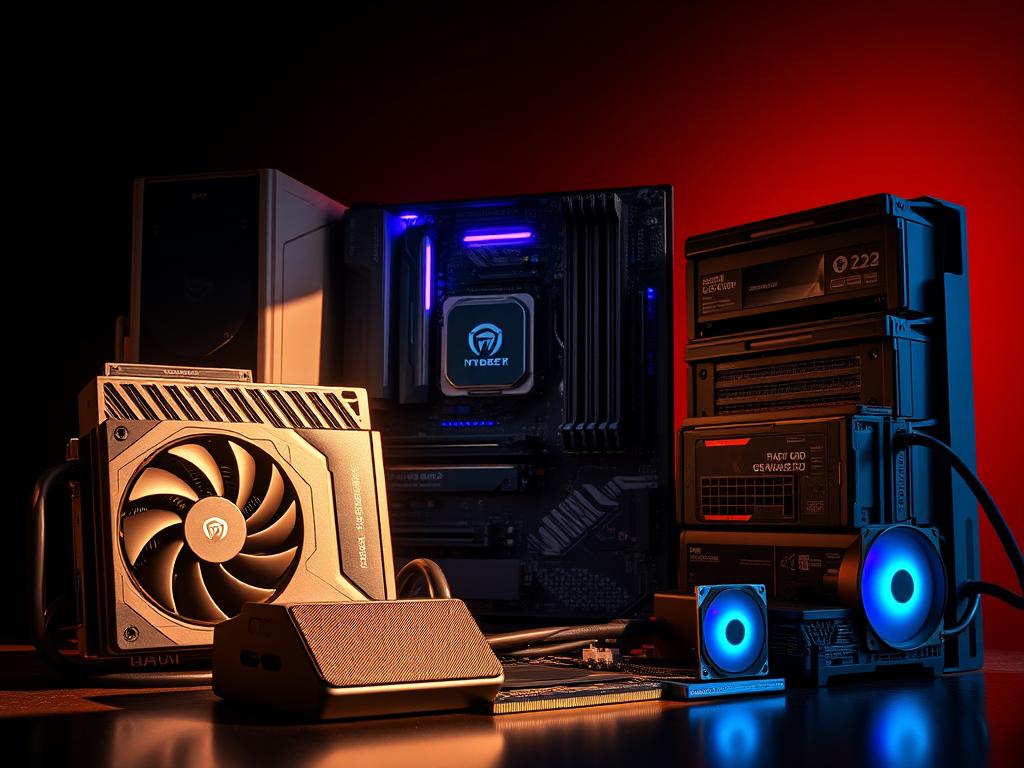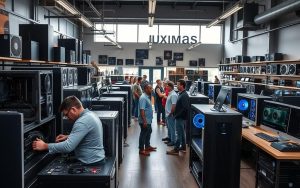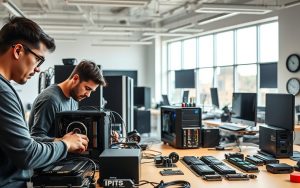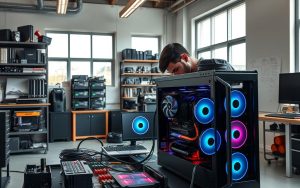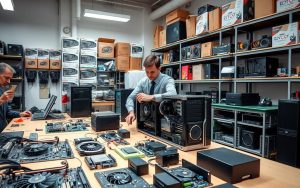Table of Contents
Crafting your own gaming PC offers unmatched customisation and performance. Understanding core components is crucial for transforming your computing experience. This journey begins with selecting the right parts for your ideal gaming rig.
Custom gaming computers provide incredible flexibility. Costs typically range from £585 to £870. Enthusiasts can tailor their machines to specific gaming requirements.
Choosing the right components ensures top performance at various resolutions. A robust motherboard like the MSI Mag B760 Tomahawk is essential. Pair it with a powerful processor such as the Intel Core i5 13400F.
Select a graphics card that aligns with your gaming goals. Budget-conscious builders can achieve impressive results through strategic component selection.
Building your own PC allows for future upgrades. It can be more cost-effective than buying pre-configured systems. With proper planning, you’ll create a rig that delivers exceptional performance.
Understanding the Basics of PC Building
PC building offers an exciting journey for gaming and tech enthusiasts. It provides a chance to create a personalised computing experience. You can tailor your PC to your needs and performance requirements.
Building your own gaming PC has many advantages. It’s both rewarding and cost-effective. The budget can vary, allowing for different financial situations.
Benefits of Building Your Own Gaming PC
- Complete customisation of hardware components
- Potential cost savings compared to pre-built systems
- Deeper understanding of computer technology
- Ability to upgrade individual parts over time
- Higher performance-to-price ratio
Cost Considerations and Budgeting
When planning your gaming PC budget, consider these price ranges:
- Low-end build: £300 – £600
- Mid-range build: £700 – £1,200
- High-end build: £1,500 – £3,000+
Required Tools and Workspace Setup
PC building tools are vital for smooth assembly. Beginners typically need:
- Phillips head screwdriver
- Anti-static wrist strap
- Clean, well-lit workspace
- Thermal paste
- Cable ties for cable management
Pro tip: Set aside 3-4 hours for your first PC build. This ensures a relaxed and methodical approach.
Gaming PC What Do I Need: Core Components Explained
Want to build a gaming PC? You’ll need to know the essential parts. This guide will explain the critical hardware basics for gamers.
Let’s break down the key elements of a gaming PC. These core components are vital for top-tier performance.
- Motherboard: The central hub connecting all components
- Sizes range from Mini-ITX to EATX
- Standard ATX motherboards measure 9.6″ in length
- Central Processing Unit (CPU): The brain of your gaming system
- Current core count ranges from 2 to 64 cores
- Most gaming CPUs feature 4 to 8 cores
- Clock speeds typically between 3.5 to 4.0 GHz
- Graphics Processing Unit (GPU): Renders visual performance
- VRAM ranges from 2GB to 12GB
- Minimum 4GB recommended for 1080p gaming
- Budget range: £200 to £500
RAM and storage are crucial for smooth gaming. Modern setups need at least 16GB of RAM with speeds of 3000 MHz or higher.
For storage, a 1TB SSD provides ample space for games and operating systems. This ensures quick load times and smooth performance.
The power supply unit (PSU) and computer case are the final pieces. Choose a PSU with enough wattage, typically 600W for high-performance systems.
Select a case that fits your components comfortably. This ensures proper airflow and easy assembly.
Pro tip: Balance your component selection to avoid performance bottlenecks and ensure optimal gaming hardware compatibility.
Component Compatibility and Performance Matching
Building a gaming PC requires careful selection of compatible parts. The right components ensure optimal system performance and prevent technical issues. Understanding how different parts interact is key to successful builds.
Proper component matching is crucial for creating a powerful gaming machine. Builders must assess various system requirements to achieve this goal.
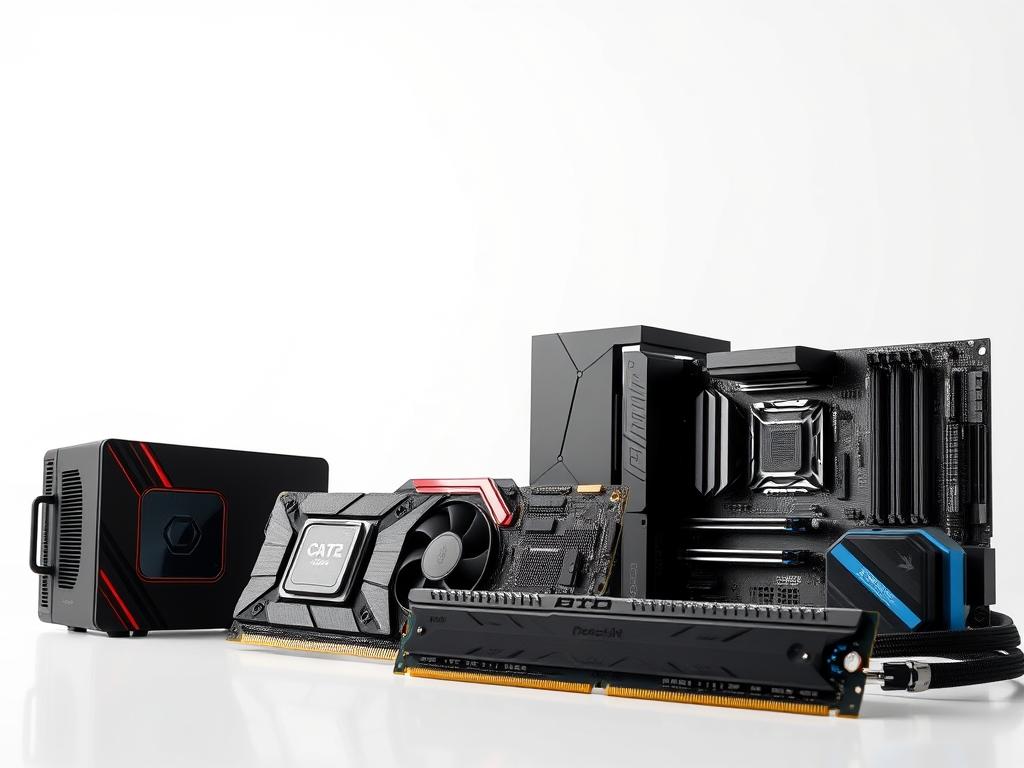
Motherboard and CPU Compatibility
Matching motherboard and CPU socket types is fundamental for any gaming PC. This ensures your processor fits perfectly and works correctly.
Key factors to consider include socket type alignment and chipset generation. BIOS version support and processor generation are also important.
- Socket type alignment
- Chipset generation
- BIOS version support
- Processor generation
Power Supply Requirements
Choosing the right power supply unit (PSU) is vital for system stability. Calculating total power draw helps avoid electrical issues during intense gaming.
| Component | Average Power Consumption |
|---|---|
| High-end CPU | 95-150 watts |
| High-performance GPU | 250-350 watts |
Case Size and GPU Clearance
Physical dimensions are crucial in component matching. Ensure your chosen GPU fits within the case through careful measurement.
- Measure graphics card length
- Check case internal dimensions
- Verify cooling solution compatibility
- Consider cable management space
Addressing these compatibility concerns helps build a robust gaming PC. This attention to detail ensures exceptional performance and reliability.
Cooling Solutions and Airflow Management
Thermal management is vital for gaming PCs. It prevents component damage and ensures reliable performance. PC cooling systems are key to maintaining optimal temperatures.
Gamers can choose between two main cooling methods. Air cooling uses fans and heatsinks. Liquid cooling employs liquid-based heat transfer.
- Air Cooling: Utilises fans and heatsinks to dissipate heat
- Liquid Cooling: Uses liquid-based heat transfer mechanisms
Most PC cases come with pre-installed fans. These are typically 120mm or 140mm in size. Strategic fan placement creates an efficient cooling cycle.
Effective thermal management requires careful planning. Keep fan noise below 30 dB for quiet operation. Aim for positive case pressure. Create an optimal airflow path from front to rear.
- Maintaining fan noise below 30 dB for quiet operation
- Achieving positive case pressure
- Creating an optimal airflow path from front to rear
A 5-fan setup is often recommended for professional cooling. This includes three intake fans at the front. It also has one exhaust fan at the back and one at the top left corner.
- Three intake fans at the front
- One exhaust fan at the back
- One exhaust fan at the top left corner
High-performance gaming rigs benefit from a 240mm AIO cooler. It balances cooling efficiency and noise levels. Brands like Be quiet! LIGHT WINGS offer silent operation with excellent thermal performance.
Selecting the Right Peripherals for Your Gaming Setup
The right gaming peripherals can transform your setup from basic to extraordinary. Top-tier gaming input devices make a significant difference in your performance and enjoyment. Quality accessories are crucial for an optimal gaming experience.
Key components require careful thought when choosing gaming peripherals:
- Gaming Monitors: Resolution and refresh rate are critical
- Keyboards: Mechanical switches provide superior responsiveness
- Gaming Mice: Precision and customisation matter
- Audio Equipment: Immersive sound enhances gameplay
Gaming monitors are a vital investment. The ASUS TUF Gaming VG279Q1R boasts a 144Hz refresh rate and Full HD resolution. For ultimate detail, 4K monitors like the MSI OPTIX G321CUV offer exceptional visual clarity.
Mechanical keyboards excel among gaming input devices. The iBUYPOWER MEK 3 RGB and ASUS TUF Gaming K3 feature 50 million keystroke lifespans. RGB lighting adds style while providing functional customisation.
Precision gaming mice round out the peripheral setup. The Logitech G PRO Wireless offers a DPI range from 100 to 25,600. Its eight programmable buttons provide flexibility for various gaming styles.
Step-by-Step Guide to Assembling Your Gaming PC
Building a gaming PC is an exciting venture into computer assembly. The PC construction steps demand careful prep and attention to detail. Most enthusiasts spend about 3-4 hours on this rewarding weekend project.
Start by setting up a clean, static-free workspace. Gather essential tools like screwdrivers and anti-static wrist straps. Proper preparation prevents potential component damage.
- Prepare a static-free workspace
- Gather necessary tools (screwdriver, anti-static wrist strap)
- Organise components systematically
Begin by installing the CPU into the motherboard. Handle the processor gently, ensuring proper alignment with socket pins. Apply a small dab of thermal paste before attaching the CPU cooler.
- Install RAM into appropriate motherboard slots
- Mount motherboard in computer case using 9 provided screws
- Connect power supply cables
- Install GPU in PCIe slot
Cable management is crucial in PC building. Organise cables neatly to improve airflow and maintain a clean internal layout. Connect power cables systematically, ensuring each component gets enough juice.
Pro tip: Approximately 90% of successful PC builders emphasise the importance of a clean, organised workspace during assembly.
Before powering on your new gaming PC, do final checks. Double-check all connections and ensure everything is securely mounted. Your patience will pay off with a high-performance gaming machine.
Conclusion: Finalising Your Gaming PC Build
Completing your PC build is thrilling. After choosing parts and assembling your custom rig, it’s time for testing and setup. Powering on your new machine requires precision and care.
Installing the operating system kicks off your gaming PC’s journey. Download the latest drivers for each component to boost performance. System testing is vital to check that everything works properly.
Keeping your gaming PC in top shape is crucial. Regular updates, driver checks, and cleaning will ensure smooth operation. Many gamers upgrade their graphics card every few years.
Your custom-built gaming PC is more than just a machine. It’s your personal hub for fun, creativity, and digital adventures. With proper care, you’ve created a powerful system tailored to your needs.
FAQ
Is building a gaming PC cheaper than buying a pre-built system?
Building a custom gaming PC is often more cost-effective. You can choose components and avoid paying for pre-installed branded markup. This approach usually saves money whilst delivering better performance than similarly priced pre-built systems.
What are the most critical components for gaming performance?
The GPU and CPU are crucial for gaming performance. They determine your system’s ability to render graphics and process game-related calculations. Investing in high-quality GPU and CPU will significantly impact your gaming experience.
How much should I budget for a decent gaming PC?
Gaming PC budgets vary widely. Entry-level systems start around £600-£800, mid-range ones cost £800-£1,500. High-end gaming rigs can range from £1,500 to £3,000 or more.
Your budget should match your gaming needs, resolution, and desired performance level.
Do I need special tools to build a gaming PC?
Basic tools include a Phillips head screwdriver, anti-static wrist strap, and isopropyl alcohol. Most PC builds can be completed with standard screwdrivers and careful handling of components.
How important is cooling for a gaming PC?
Cooling is vital for maintaining optimal performance and preventing thermal throttling. It helps maintain consistent performance and extends component lifespan. Options include air cooling, liquid cooling, and strategic case airflow management.
Can I upgrade my gaming PC components later?
Yes, upgrading components is a key advantage of building your own PC. Most parts like RAM, storage, GPU, and sometimes CPU can be replaced later. This provides long-term flexibility and value as technology advances.
How long does it take to build a gaming PC?
First-time builders typically need 2-4 hours. Experienced builders can complete a build in 1-2 hours. This includes careful component installation, cable management, and initial system setup.
What peripherals are essential for a complete gaming setup?
Essential peripherals include a high refresh rate monitor, responsive mechanical keyboard, and precision gaming mouse. Quality headphones or speakers are also important. These components greatly enhance your overall gaming experience.
How do I ensure component compatibility?
Use online tools like PCPartPicker to check compatibility. Ensure matching motherboard socket types for CPU and verify power supply wattage. Check GPU and case dimensions, and confirm RAM compatibility with your motherboard.
What operating system should I use for gaming?
Windows remains the primary gaming operating system. It offers the most extensive game library and driver support. While Linux and macOS have improved, Windows provides the most comprehensive gaming ecosystem.


